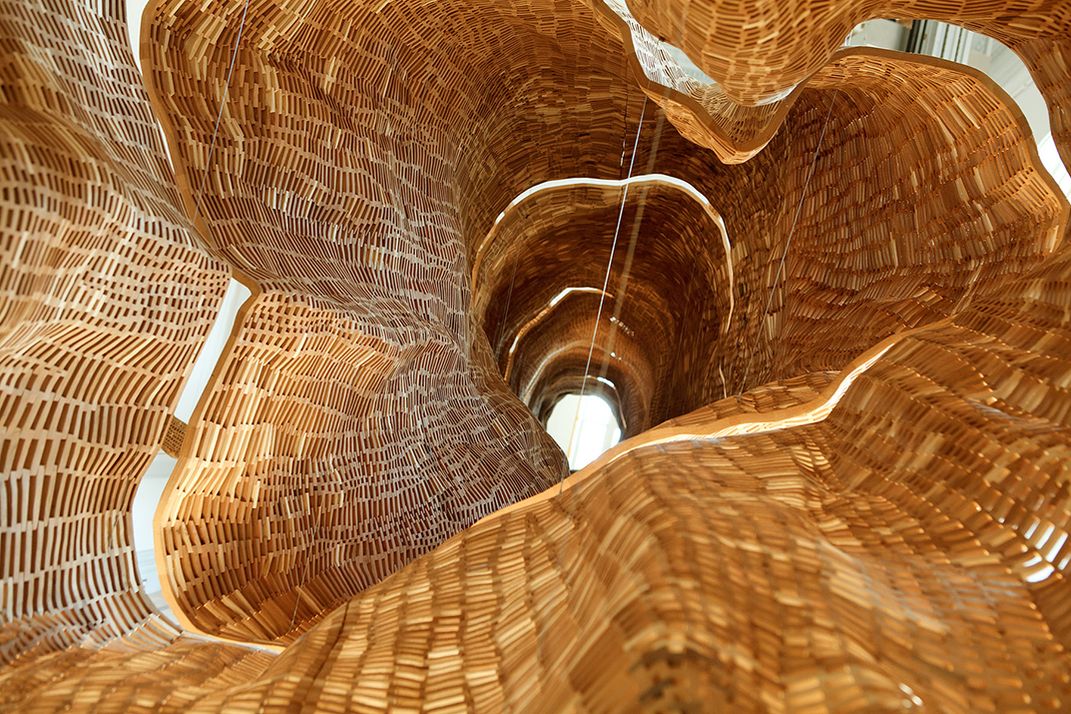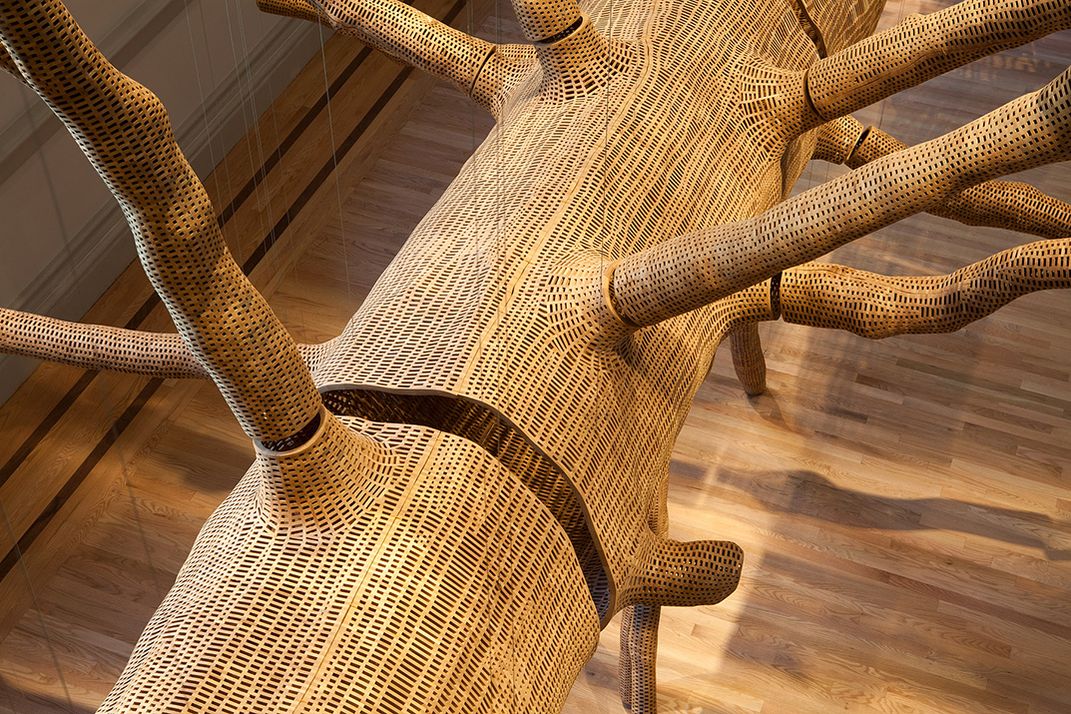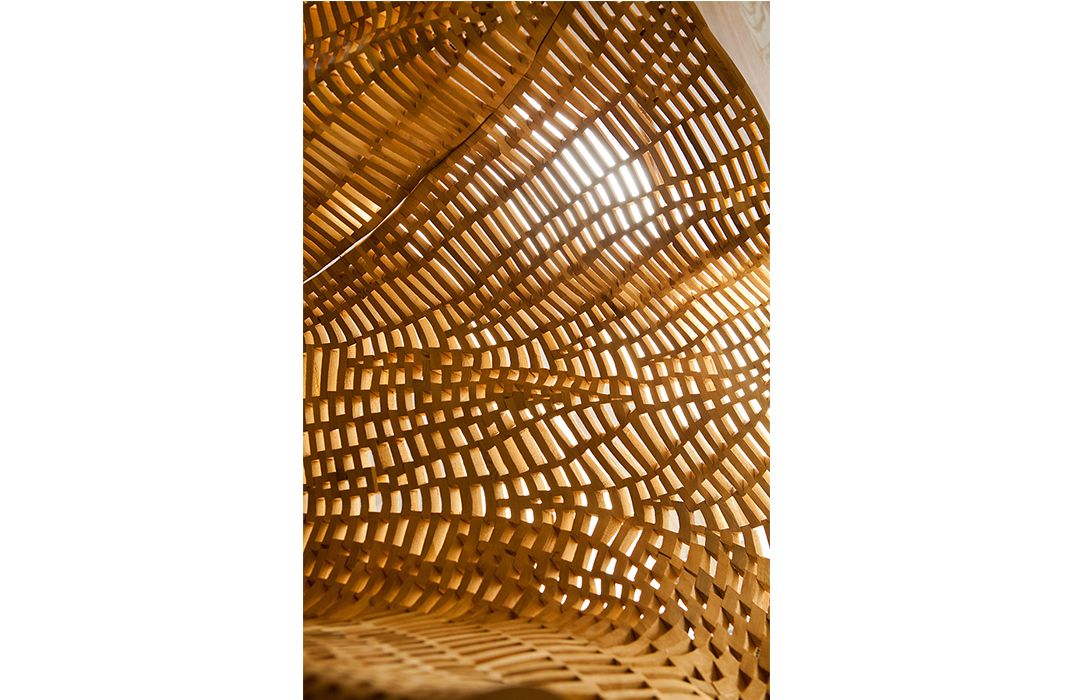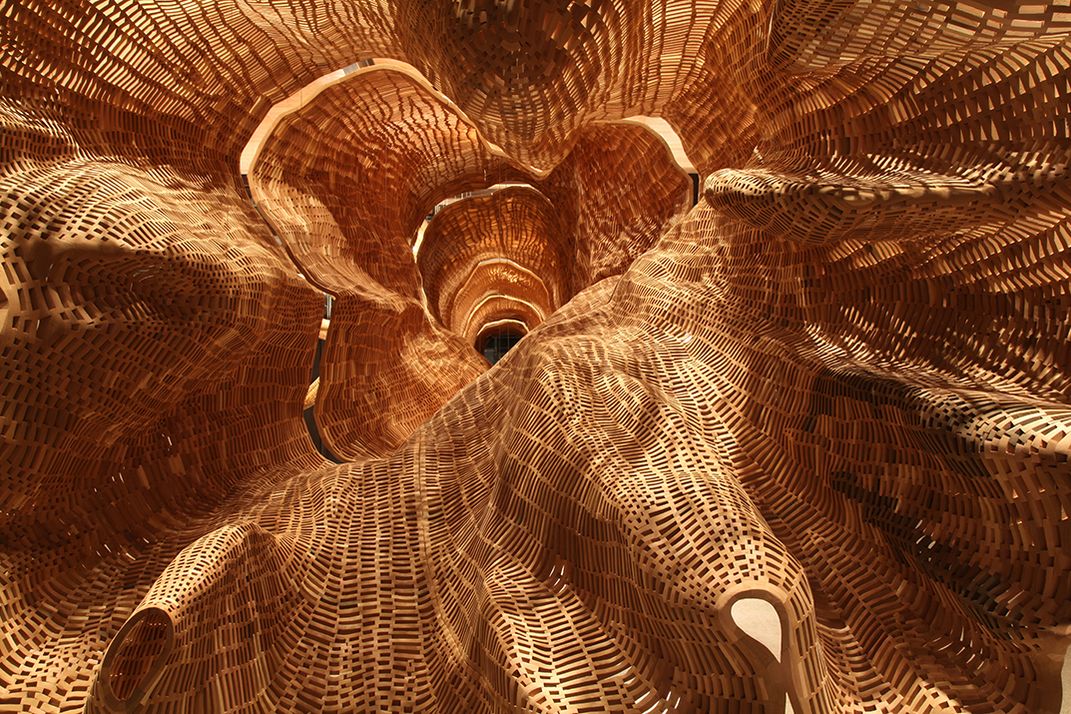This Artist Recreated a Magnificent 40-Foot-Tall Tree From the Cascade Mountains by Hand
Artist John Grade painstakingly built a 150-year-old giant hemlock out of half a million blocks of reclaimed wood
/https://tf-cmsv2-smithsonianmag-media.s3.amazonaws.com/filer/91/9c/919c6213-0afc-4648-9621-7004f8c1ce36/grademiddleforkinstallweb.jpg)
For the grand reopening of Washington, D.C.’s Renwick Gallery, artist John Grade set out to do something grand.
He wanted to bring a 40-foot tree into the gallery. He had just the tree in mind—a 150-year-old hemlock located in the Cascade Mountains (east of the artist’s Seattle home). About the same age as the Renwick itself, and a size that would just fit into the gallery space if hung parallel to the floor, the grand old hemlock was ideal for the site-specific project Grade had in mind.
But as a lover of nature whose works play on the ideas of natural degradation and man’s impact on the environment, Grade was not about to chop the hemlock down. As an artist who prizes handcrafted detail, he also was not interested in using any digital tools to copy the tree’s dimensions. He had a much more elegant—if far more complicated—plan.
He hired arborists to work with his team; who roped up the tree, setting up a pulley system to haul up buckets of water, so that a handcrafted plaster cast of the tree could be rendered—all while ensuring that the magnificent tree was carefully protected throughout the process.
“I could have been very practical and gone in and scanned this tree in an hour,” says Grade. “But actually being up in the tree and getting the sense of the thing more intimately flowing down was important for myself and for the people casting it.”
Once the cast was made, he brought the shell of the hemlock back to his studio, in large segments. And that was when things got even more complicated.
/https://tf-cmsv2-smithsonianmag-media.s3.amazonaws.com/filer/11/8f/118f9a7b-ba88-4c4b-a043-8636b449433a/gradebygradeweb.jpg)
Using about a half million segments of reclaimed, old-growth cedar—each scrap individually measured, trimmed and sanded—Grade and his team began gluing a piece at a time to the cast. In this way, over many months and with the help of hundreds of volunteers, he was able to recreate each detail of the original tree by hand, creating the original tree’s doppelganger woven out of wood.
The work, titled Middle Fork, is part of the inaugural exhibition "Wonder," opening November 13, when the doors of the Smithsonian American Art Museum’s Renwick Gallery finally reopen after a major two-year renovation. The show brings together nine artists, including Grade, charged with the task of inspiring awe by transforming the space with their site-specific installations.
Important to Grade was the fact that it was a group effort. While Grade guided the process, he opened it up to “anyone who wanted to be involved with the project,” in the studio space, with 50 feet of windows in a very busy part of Seattle.
“The idea was people walking by,” says Grade, “would be invited in to join us.”
Volunteers were started on simple sections of wood, shaping them with one of Grade’s assistants right at their side helping guide them. Experienced volunteers could tackle sections that were more complex: those where the bark folded in on itself or where a limb connected into a trunk of a tree.
“It kind of rewards people who want to continue with the process,” he says.
But as impressive as the 40-foot replica of the Pacific Northwestern specimen may be, Middle Fork is complemented by a second tree cast that is also on display. In addition to the large tree from the Cascade Mountains, he made a cast of a smaller tree from a very different region: deep in the Alaskan Arctic, north of the Brooks Range.
“I found a tree as far north as I could, about 100 miles north of the Arctic Circle, where trees aren’t really supposed to grow,” he says.
Rather than tromping out with a large team of arborists and assistants, as he did for the first tree, Grade and his wife, Maria, were airlifted into the Arctic and dropped off with a raft provisioned with enough food for 10 days. The pair headed downriver in search of the perfect cottonwood. Also roughly the same age as the Renwick, this six-foot tree “almost reads as a limb to the large tree.” Grade aimed for the smaller specimen to embody a sense of the extreme or “out-of-whack,” indicative of how things are changing with the climate.
“It’s not supposed to be heavy-handed, but playing with the idea of finding a tree where we don’t expect to find it,” he says.
It took about a year to create both tree casts, and each cast is about the thickness of a year’s worth of tree growth.
“There’s this image I get in my mind that we could take the sculpture, and if it was just a little more pliable you could actually put it right over the tree,” says Grade.
In the gallery, Grade retrofitted the trees’ limbs to the dimensions of the space, so that the viewer experiences an immersive experience with the sculpture’s floating branches. Powerfully tactile and “real” rather than virtual, its gravity defying heft delivers on the awe factor of “Wonder.”
“The making of these trees was so much in that spirit—in terms of dodging the ease of digital and instead doing this all by hand,” says Grade. “But also bringing in hundreds of people to directly engage instead of being passive viewers.”
The literalness of casting an exact replica from life is unusual for Grade, who more typically works in abstract shapes. Also unusual will be the afterlife of the work after it is deinstalled at the Renwick on May 8, 2016. Grade says the larger tree will be shown at a couple other venues and then “planted” next to the original tree.
“It will at first be this kind of beautiful shadow of the original form, but then over the years it will moss over and fall apart and eventually just completely disintegrate,” he says.
This differs from Grade’s other works, which the artist has exposed to the elements first. For example, La Chasse, a project about twice the size of this one that he planted in northern France, on which a wild boar came through and attacked almost daily. Or Fold, a large wood and resin structure that has been buried in Idaho among termites since 2008, which eventually he plans to excavate and display.
“This is kind of an inversion—you see it before it goes out to nature,” says Grade.
John Grade is one of nine contemporary artists featured in the exhibition “Wonder,” on view November 13, 2015 through July 10, 2016 at the Renwick Gallery of the Smithsonian American Art Museum in Washington, D.C. Grade's installation closes on May 8, 2016.
/https://tf-cmsv2-smithsonianmag-media.s3.amazonaws.com/accounts/headshot/Alex_Palmer_lowres.jpg)







/https://tf-cmsv2-smithsonianmag-media.s3.amazonaws.com/accounts/headshot/Alex_Palmer_lowres.jpg)